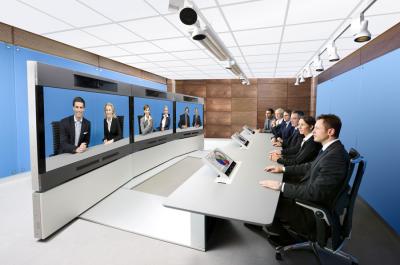Polycom Pushes High-End Video Conferencing

Video conferencing specialist Polycom says its HD-ready system, will boost take-up of telepresence, and cut business travel, but analysts warn of slow uptake and hidden costs around the technology
The latest version of the Poylcom’s company’s RMX 2000 video conferencing system is capable of producing broadcast-quality 720p high-definition images and supporting high-end video conferencing known as telepresence.
“The future-focused RMX 2000 platform is designed for high-definition applications like telepresence and is the only conference platform that delivers the full range of HD video resolution support up to 1080p,” said Joe Sigrist, senior vice president and general manager of video solutions at Polycom.
The system does not come cheap at around £28,000 – but this is still considerable less than a fully functioning telepresence system from Cisco or Tandberg which can weigh in at more than £200,000.
Given the dire economic conditions, Polycom is keen to point out that the RMX 200 system also supports more low-end videoconferencing systems including desktop level use of the technology. “It is also the only platform that can be optimised for either pure HD environments or for mixed-resolution environments, giving customers the flexibility to adapt their infrastructure as application needs change, ” said Sigrist.
Polycom’s decision to support high and low end video conferencing is a reflection of customer uptake of the technology according analysts. “While it’s true that HD resolution is of great interest to many customers, our research indicates that most organisations today have mixed-resolution video conferencing environments. In addition, at this time the majority of the HD-capable videoconferencing systems deployed are primarily used for non-HD video calls,” said Ira Weinstein, partner at Wainhouse Research.
Videoconferencing has been heralded as one of the IT industry’s key weapons in combating climate change and helping companies cut corporate travel costs.
A recent study from European Telecommunications Network Operators Association (ETNO) and the World Wildlife Fund revealed that if 20 per cent of business travel in the EU was replaced with telecoms technologies, by 2010 around 25 million tonnes of CO2 would be saved each year.
However some technology analysts have pointed out that video-conferencing systems, particularly high-end telepresence systems carry hidden up-front costs and there are significant cultural issues to overcome in order to ensure staff actually use the systems.
“Enterprises need to plan carefully to integrate videoconferencing into their VoIP and unified communications strategies and to avoid buying expensive islands of videoconferencing for senior managers that cannot interoperate with simpler technologies across the business,” said Forrester analyst Phil Sayer.
Analyst Gartner says although so far less than 5 percent of systems are HD, the technology could eventually fuel a 20 to 30 increase in the use of videoconferencing technology over the next two years as the improved resolution helps attract users. But the analyst also warned that companies need to plan any roll-out carefully and consider the costs of having a dedicated room for high-level conferencing as well as providing adequate network bandwidth.